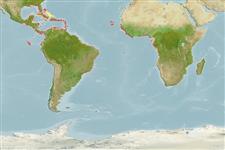Common names from other countries
Classification / Names / Names
Nomi Comuni | Sinonimi | Catalog of Fishes (gen., sp.) | ITIS | CoL | WoRMS
Environment: milieu / climate zone / depth range / distribution range
Ecologia
; salmastro; distribuzione batimetrica 0 - 2 m (Ref. 101599). Tropical; 33°N - 30°S, 98°W - 14°E
Atlantic Ocean: from Florida to Bermuda, Mexico, Belize, Panama, the Antilles, Colombia, Venezuela, the Guianas, to Brazil (Para to Santa Catarina, including Fernando de Noronha), and the eastern Atlantic, from Senegal to Angola.
Length at first maturity / Size / Peso / Age
Maturity: Lm 2.5, range 2 - 2.9 cm Max length : 5.6 cm CW maschio/sesso non determinato; (Ref. 102095); 5.1 cm CW (female)
Inhabits brackish muddy waters, often in mangrove swamps (Ref. 435), able to move fast between the roots and trunks of trees (Ref. 104080). Found in burrows (Ref. 86356), from intertidal to supratidal waters (Ref. 97531). Excellent predator in the mangroves (Ref. 104080). Feeds on mangrove propagules and animal matter (Ref. 86356). First marine crab reported to feed on an amphibian Leptodactylus macrosternum, wherein the frog was found near the crab's burrow (Ref. 104080).
Fischer, W., G. Bianchi and W.B. Scott (eds.). 1981. (Ref. 435)
IUCN Red List Status (Ref. 130435)
CITES status (Ref. 108899)
Not Evaluated
Not Evaluated
Human uses
Pesca: commerciale
| FishSource |
Strumenti
Fonti Internet
Estimates based on models
Preferred temperature
(Ref.
115969): 25.2 - 28.1, mean 27.4 (based on 644 cells).
Resilienza
Alto, tempo minimo di raddoppiamento della popolazione meno di 15 mesi (K=2.24-2.5; tm=0.23).
Vulnerability
Low vulnerability (10 of 100).
Price category
Unknown.
